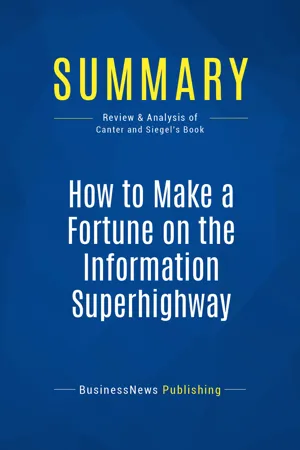
Summary: How to Make a Fortune on the Information Superhighway
Review and Analysis of Canter and Siegel's Book
- English
- ePUB (mobile friendly)
- Available on iOS & Android
Summary: How to Make a Fortune on the Information Superhighway
Review and Analysis of Canter and Siegel's Book
About this book
The must-read summary of Laurence Canter and Martha Siegel's book: `How to Make a Fortune on the Information Superhighway: Everyone’s Guerrilla Guide to Marketing on the Internet`.
This complete summary of the ideas from Laurence Canter and Martha Siegel's book `How to Make a Fortune on the Information Superhighway` shows that internet marketing is now essential, as most successful businesses understand that the internet is where people spend time, therefore companies must integrate themselves into the community. However, it’s remarkable how some businesses still fall into traps that are easily avoidable. The authors point out that interactive marketing is far more effective online than simply advertising, because companies can set up an efficient feedback loop whereby they not only sell products but improve products at the same time. This summary takes the reader through some very simple techniques – such as the best way to set up a mailing list – for creating multimedia advertising strategies.
Added-value of this summary:
• Save time
• Understand the key concepts
• Increase your business knowledge
To learn more, read `How to Make a Fortune on the Information Superhighway` and discover the road towards a coherent, profitable online marketing strategy.
Frequently asked questions
- Essential is ideal for learners and professionals who enjoy exploring a wide range of subjects. Access the Essential Library with 800,000+ trusted titles and best-sellers across business, personal growth, and the humanities. Includes unlimited reading time and Standard Read Aloud voice.
- Complete: Perfect for advanced learners and researchers needing full, unrestricted access. Unlock 1.4M+ books across hundreds of subjects, including academic and specialized titles. The Complete Plan also includes advanced features like Premium Read Aloud and Research Assistant.
Please note we cannot support devices running on iOS 13 and Android 7 or earlier. Learn more about using the app.
Information
Summary of How To Make A Fortune On The Information Superhighway (Laurence Canter and Martha Siegel)
1. INTERNET BASICS
- What equipment is needed to get on the Internet?
The basic tools required are:- Personal computer - any brand, any speed, any type. The faster the better, but in reality any computer will do.- A modem - again, any modem will do but in practice the quicker the better.- A telephone line.- A printer for making hard copies of electronic messages you receive.- A communications program - which allows the computer to talk to the modem. (Most Internet service providers will also provide this software free of charge). - How do you gain access to the Internet? You open an account with a company which provides commercial Internet access. They currently advertise regularly in major newspapers, and are easy to contact. There are a number of account charging options and you should be prepared to experiment with a few service providers and different charge structures until you find the optimum set-up for your own particular business operation.
- What can you do on the Internet? The four primary functions of the Internet are:- Electronic mail (e-mail). Everyone on the Internet has ...
Table of contents
- Title page
- Book Presentation
- Summary of How To Make A Fortune On The Information Superhighway (Laurence Canter and Martha Siegel)
- About the Summary Publisher
- Copyright